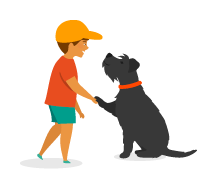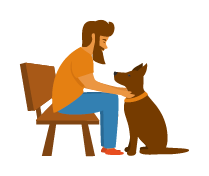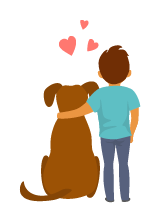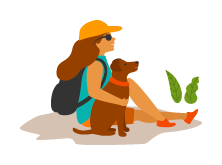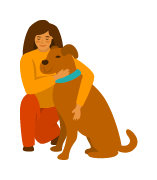The Ultimate New Puppy Guide
Welcoming a new puppy into your home is an exciting and heart-warming experience.
In this comprehensive guide, we’ll walk you through the essential first steps to ensure a smooth transition for both you and your new furry friend.
In this all-new guide you’ll learn:
- How to understand your puppy’s behaviour
- How to introduce them to the big wide world
- How to puppy proof your house
- How to handle your puppy’s first night
- Lots of great tips and techniques
Get ready to embrace the joys and challenges of puppy parenthood with confidence and joy!
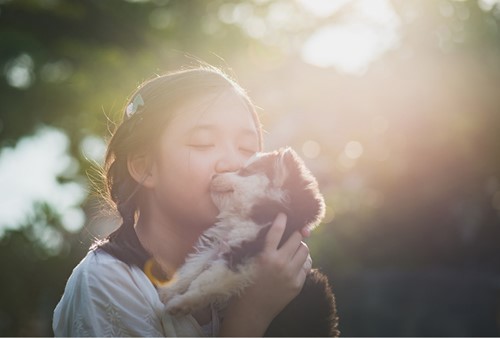
Contents
- Chapter 1: Collecting your pup
- Chapter 2: What to expect on the first day (and night)
- Chapter 3: How to train your puppy like a pro
- Chapter 4: Puppy behaviour explained
- Chapter 5: Introducing your puppy to the big, wide world
- Chapter 6: Protecting your puppy for the future
Welcoming a puppy into your home is one of the most exciting – and most daunting – things you can do. As with many things in life, preparation is key. That’s why we’ve compiled this fact-filled, practical guide to help you navigate puppyhood with ease.
A whopping 24% of adults in the UK own a pup, so it’s clear to see we’re a nation of dog lovers. If you choose to adopt a puppy from a good rehoming charity, you can rest assured your four-legged friend has had a full vet check, behaviour assessment and some basic training.
But if you choose to get your new pooch from a breeder, how do you make sure you’re buying your puppy legally and safely? There are many unscrupulous breeders who put profit over pup welfare. A good, law-abiding breeder will not sell a puppy until it’s a minimum of eight weeks old and microchipped. You should be able to see the litter happily alongside mum in a clean, safe environment.
There are some standout benefits of puppy ownership. Unlike adult dogs, puppies are still forming their personalities and impressions of the world. Every day is a new adventure and they’ll be looking to you, the owner, to guide and teach them. From ‘sit’ to ‘roll over’, crate training to recall, training a puppy is an incredibly rewarding experience that helps build a strong bond between owner and pooch.
Throughout this guide, we’ll walk you through the key issues to consider when bringing your puppy home, starting with collection day. We’ll prepare you for the first day and night, show you how to navigate crate training and answer some common questions such as ‘why does my puppy want to play at 2am?’
Chapter 1:
COLLECTING YOUR PUP
Congratulations! You’ve found the puppy of your dreams and it’s almost time to pick them up. So what’s next?
Accessories for your new pup
Before you make that exciting journey to collect them, you’ll need to stop at the pet shop to pick out the perfect bed for your pooch, taking into account their size. You’ll also need food and water bowls, dog food suitable for your puppy’s age and breed, plus some training treats.
Puppy food is usually fortified with the vitamins and minerals they need at this early stage, so make sure you buy food that’s right for their age group. Puppies are notoriously chew-happy, so no pair of shoes or book is safe! Puppies teethe for around six to eight months, so it’s a good idea to stock up on puppy-safe, chewable toys.
You’ll also need a collar and lead for when you take your pooch out and about for the first time.
Vaccinations and microchipping
It’s vital to find out from the breeder or rehoming centre whether your new pup is fully vaccinated. Your puppy should be vaccinated twice – once at six to nine weeks of age and again when they reach 10-12 weeks. They also suggest taking your new puppy for a health check within the first two days of ownership.
A good breeder will also be able to provide paperwork confirming your puppy is microchipped. This is important, because it means the breeder’s details will be registered against the microchip on an approved database for the entirety of your dog’s life, alongside your own contact details.
A microchip acts as a link between you and your beloved pooch and if he or she goes missing, your contact details will be found and you’ll be reunited as quickly as possible. Without a microchip, it’s much harder to trace your dog’s whereabouts, not only causing heartache but also incurring additional costs associated with your search efforts.
"It is now a legal requirement to have any dog over the age of eight weeks microchipped in England and Wales. It's a dog breeder's responsibility to ensure puppies are microchipped before selling them- so, if you're buying a puppy, make sure they're microchipped before taking them home."
Transporting your new puppy
When you arrive to collect your nervous new puppy, it’s important to remain calm and upbeat. We recommend that you have a harness or crate ready, so your puppy can be transferred safely. Remember, your pup should be able to stand and turn with ease when in the crate.
Try to avoid travelling for extended periods of time, especially if you’re picking them up in the middle of summer, as it will be hot in the car. And always have some water and a bowl on hand in case you need to stop to give them a drink.
When lifting or holding your puppy, focus on supporting its chest and backside, placing one arm beneath the backside and one around the chest. Draw him or her close for extra security and speak to them in a calming voice. Your pup is finally yours – time for snuggles!
Top 10 questions for the seller
Before you whisk your pup away, ask the breeder or seller these quick questions. Every good breeder should be able to answer these:
- Do the puppies come vaccinated, wormed and microchipped along with genuine certification? If not, where can I get this done?
- If your puppy is a breed known to suffer from hereditary health issues, can the breeder provide certification these have been screened for?
- Are any of the puppies sick or suffering from on-going health issues?
- Can you see the puppy alongside mum and her litter, as well as where they sleep?
- What is mum’s history, how many litters has she had?
- Can they show you their Local Authority licence (if they are breeding as a business)?
- What food does the puppy currently eat and can I take some with me?
- Can I bring the puppy back if any health issues arise?
- What level of training/socialisation has my puppy had already?
- How much human contact do mum and her puppies have each day?
New puppy Q&As
Q. Why is my puppy whining all night?
A. Puppies tend to communicate their needs by crying, just as a new-born baby would. Puppies often cry due to loneliness, as they acclimatise to life away from their mum. Keeping your puppy nearby is a good way to remedy this, as is spending quality time with them.
Fear also plays a role in whining, as puppies go through “fear periods” during which they’re frightened by a multitude of new things they previously ignored. Hunger and boredom are additional causes of whining, however, if your pup seems to whimper a great deal and seems unwell, it’s always best to consult a vet.
Q. Why is my puppy biting?
A. It’s normal for a puppy to play-bite, but factors such as excessive confinement, rough play, teasing and overenthusiastic greetings from family/visitors can encourage bad biting habits.
Q. Why is my puppy destructively chewing?
A. Puppies are infamous for chewing through anything and everything – no chair leg or cuddly toy is safe! The teething process is normal, however, destructive chewing may occur due to poor nutrition, boredom, loneliness or, shock horror, the scent of nearby mice!
Q. Why does my puppy keep climbing on the furniture?
A. As with many destructive puppy habits, climbing on the furniture is often due to boredom. Other factors include residual food or interesting items left on furniture or dissatisfaction with an uncomfortable sleeping area. It might be time for a basket upgrade.
Q. Why does my puppy keep jumping up?
A. If your pup is greeted with a chorus of excitement, it’s likely he/she will get excited too and jump up. Another reason for jumping up is a desire for attention. Read on to find out how to cope with biting, chewing, barking and more.
Chapter 2:
WHAT TO EXPECT ON THE FIRST DAY (AND NIGHT!)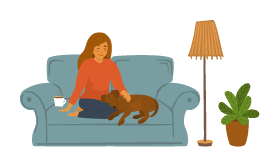
It’s day one. You may be feeling a little nervous – your pup definitely is.
New sounds, smells and no more mum mean most puppies are a little apprehensive when they reach their new home. Whilst there's plenty you can do to ease the transition, the most important step is to puppy-proof your house, providing a safe environment for your pooch to learn and play.
How to puppy proof your house
Getting down to puppy-level is actually a great way to view your home from the perspective of your four-legged friend! Are the kitchen cupboards or bin a little too accessible? Is that bottle of bleach within paw’s reach? Be it food, medicines or household products, many of these can be toxic to your beloved pooch, so ensure they are kept in a secure place.
Likewise, whilst your favourite arrangement of flowers or potted plants might seem harmless, these too could be toxic to your puppy. We recommend that you research dog-friendly plants and removing those that are harmful. This is not a comprehensive list, but some of these include:
- Gypsophila
- Crocus
- Calla Lily leaves
- Holly berries
- Hyacinth bulbs
- Ivy
It's also worth stepping outside and checking for any puppy-sized gaps in your garden's perimeters. Make sure your fencing is high and strong enough to keep your pup secured safely inside. Safety-proof any garden ponds or streams as well, in case your pup decides to take an impromptu dip!
Ensure your pup is protected from exposure to plug sockets and any sources of heat inside the house, too – socket protectors and fireguards are readily available from DIY stores or online.
In case you want some extra helping in training your pup, check out our recent blog on what happens at a puppy training class.
Where to put your pup's bed
So you’ve puppy-proofed your house, what next? Time to create a relaxing area dedicated to your pampered pup. A crate is a great way to provide your puppy with a secure and cosy hangout for rest, peace and quiet. You can place your puppy’s bed inside the crate, along with blankets, toys and a bowl of water.
Ensure the crate/bed is positioned away from direct heat sources, draping a sheet over the sides, top and back to create a snug environment for your pup. Whether your pup sleeps upstairs or downstairs, place the crate somewhere central to family activity. Check out our top tips for crate training your pup below.
But for now, let the fun begin – your pooch can move in!
Make the first day a success
It’s easy to forget how nerve-wracking the first day is for a puppy exploring a new home. It is very important that you allow your pup to have some quiet time to process their new surroundings, free of bother and hassle. Remember that puppies sleep a great deal, so if they’re not resting and it’s been a little too quiet for a little too long, chances are some naughty business is taking place!
We also recommend having familiar toys and distractions to hand, keeping your puppy busy, relaxed and less focused on missing mum and the rest of the litter. This will help build positive associations between your pup and his/her new home.
It's useful to find out what your puppy's feeding and toileting schedule is before bringing them home, as this helps avoid unnecessary stress whilst you're both acclimatising. Ask the breeder or rescue centre whether your puppy will indicate a desire to go and toilet outside.
If they're only familiar with toileting indoors, make sure to have plenty of newspaper or toileting pads to hand
and allocate a suitable place for your pup to do
his/her business.
Likewise, don't make any radical changes to your pooch's diet or feeding schedule. Mirror the routine they're already accustomed to, making any alterations slowly.
Don't worry if the bowl of biscuits remains untouched on day one, as your pup may not be in the mood to tuck in, but try to encourage eating when possible.
Older dog meets newer dog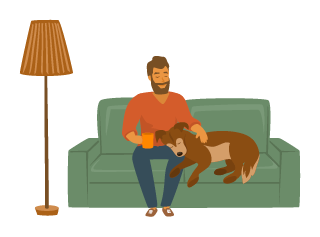
Introducing your existing dog to a spritely new pup can be daunting. Will they get on or won’t they? It is recommended that you pick neutral turf for the two pooches’ first meeting, as this will lessen the chance of your existing dog becoming territorial.
An outdoor introduction is the best way to go, but only consider this if your puppy is fully vaccinated. If your pup has only had his/her first vaccination and your vet gives the green light, you can still consider an outdoors introduction, but restrict this to your garden.
Let your pup have a real roam around the garden and get acquainted with all the nooks, crannies and scents. Once your pup seems at ease, pop on the lead and bring out your other dog, also secured on a lead. By nature, dogs are curious creatures and will want to get a sense of one another, which should be encouraged. Keep the leads relaxed and allow them to approach, keeping calm and reinforcing positive behaviour with words, treats and strokes.
If one of the dogs (or both) gets agitated, don't exhibit signs of panic – it's important you remain calm and composed. Wait until they match your demeanour or try a cooling off period, then have another attempt.
Once they’ve hit it off, we suggest you let your older dog ‘invite’ your pup inside. Keep both pooches on their leads, until your pup has looked around and your older dog is relaxed. Hopefully, a beautiful friendship will flourish!
If you’re a cat owner, we recommend keeping your feline friend in a different section of the house, introducing them to your pup over time – not on day one.
How to handle your puppy's first night
The first day has gone (relatively) smoothly, with a few accidental puddles and plenty of fun. Now it's time for you and your new pup to brave the first night. Spending the night alone can be frightening for a puppy separated from their family for the first time.
If you wish to have your pup sleep upstairs, we do not recommend letting your pooch spend the night on your bed with you, unless you’re certain you want to share your duvet for the foreseeable future! After just one night your pup will expect it, and making changes to their sleeping arrangements becomes more difficult.
Start as you mean to go on!
Whether you want your pup sleeping upstairs or downstairs long-term, we suggest having them sleep in your room, in their bed/crate for the initial few nights. Place blankets and toys in their sleeping area to create a homely, snug feel.
To get your pup used to sleeping downstairs, move their bed/crate further away each night, until you reach the required space. This will feel like a less drastic separation for your pup, helping to build their sense of safety and security in their new home.
The first night is unlikely to be totally peaceful, as your pup may whimper or cry some of the time – this is completely normal so try to be strong. Top things to remember are:
- Don’t be tempted to call out to your pet – you may think this is reassuring but if they can hear you, they will continue with the whining until you show up.
- If your pup is still crying non-stop after 30 minutes, go and check on them because they should have settled themselves by now and there may be something genuinely the matter - like they need the loo!
- Don’t hang around. Exciting them with play and cuddles now will only make the whole process longer. Speak in a soft voice, make sure they’ve got their toy and they’re safe and then walk away.
- Be prepared for several puppy toilet intervals as well. Your hard work will pay off as you're laying the groundwork for a balanced, happy pooch.
- Remember, consistency is key, so be strong and make sure you have enough time to dedicate to getting this important sleeping stage right. If you can, take a few days off of work, too. That way, you’ll have more bonding time with your gorgeous fourlegged friend and you won’t be tired and irritable in the morning!
Crate training
A crate is an ideal way to provide your puppy with a secure and snug space of its own. It should be a positive place for your pup, not a form of punishment. Consider the breed and adult size when purchasing a crate, as they should be able to stand, turn and stretch with ease. Here are some handy crate-training tips!
Introduce your pup to the crate gently by throwing in some yummy snacks and letting them have a sniff around. Do not close the crate door.
If your pooch seems anxious around the crate and reluctant to investigate, don’t worry. Place toys or treats near the crate, building their confidence, then finally moving the rewards inside.
After your furry pal has had a few days of freely wandering in and out of the crate, you can start closing the crate door for a few moments at a time. Gradually build the length of time the door is closed, keeping an eye on your pup's wellbeing at all times.
Your next step is stepping away! We suggest a gradual approach, stepping further away each time before returning. Once your pup seems fine with you walking about and ducking out of the room intermittently, you can consider leaving them for a maximum of three hours.
We know how exciting the first few weeks with your adorable new pup can be. However, this is a vital period, during which bad habits are potentially formed so again, consistency is key!
Top 5 mistakes new owners make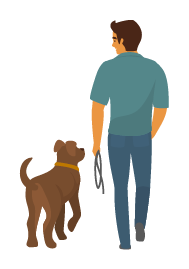
Unrealistic toilet training expectations
Each puppy is different, and some will take longer to toilet train than others. When you initially toilet train your pup, it’s likely to include newspaper or training pads.
Once your puppy is fully vaccinated and able to explore the great outdoors, don’t simply remove their indoor toileting pads. Gradually move the pads towards the door they’ll use to leave the house, finally placing them outside.
Letting your pup go outside too soon
Of course, once you’ve got your new puppy all you want to do is take them outside and play. Unfortunately, until your pup is fully vaccinated this will put his/her health at risk. A puppy’s immune system is vulnerable to all kinds of infections until vaccinations are complete so don’t risk it.
Impatience
Puppies are distractible, naughty and inexperienced. This means they’re often not ideal students when it comes to training! Whilst it’s necessary to be firm when training your pooch, it’s never ok to physically intimidate or shout at them. To effectively train a puppy you need tons of empathy, patience and a healthy dose of realism.
Excessive attachment
If you keep your puppy glued to your side at all times, separation anxiety is much more likely to be an issue – you’ll find it harder to train them to feel content on their own.
Lack of boundaries
Who could resist those puppy-dog eyes? Well, if you want a happy and balanced pooch, you need to start practising! Enjoy snuggles, games and fun with your pup, but remember to implement boundaries at all times. Discourage bad habits such as nipping from day one.
Chapter 3:
HOW TO TRAIN YOUR PUPPY LIKE A PRO
Toilet training a puppy is a long-term commitment that demands patience, focus, repetition and positivity.
Although some are fast learners, it tends to take a puppy four to six months to be completely house trained. Don't panic. If you follow a consistent schedule, you’ll find some loving guidance goes a long way and deepens your bond with your furry friend. Let's get started!
Where to begin?
At the start of house training, your own availability should be a key consideration. Ideally you should have several weeks of free time to focus on your pup at home. A pooch needs to learn in familiar surroundings and will have to go out several times a day, which doesn't fit around most day jobs!
We suggest structuring your training routine around your puppy’s needs, keeping a record of when sleeping and toileting takes place. This is the best way to avoid accidents and shape new habits. Puppies urinate soon after waking up, and typically fifteen minutes after eating a meal. Defecation tends to occur within thirty minutes of eating.
Similar to very young children, puppies are learning to control their bladders. They have small bladders as well as poor bladder control, so they need to urinate often. PetMD also cites breed size as an indicator for bladder control, as smaller breeds tend to have smaller bladders, so need more regular trips outdoors.
Whatever breed your pooch is, it's best to take them out to toilet every one to two hours. It's unlikely they'll be able to hold all night long, so if you have them upstairs with you, prepare for a few moonlit excursions outside! If they're downstairs, it's likely you'll be met with some soiled paper or toileting pads in the morning.
We advise you take your pup out whenever they get excited, as this stimulates the bladder. It’s also wise to take a trip to the garden after playtime and naps. Whining, sniffing, barking, circling and scratching are other classic signs that your pup needs to go!
Experts recommend restricting your pup to a designated space when toilet training, be it a crate or room. This will help create a divide between the area you train your pooch to toilet in and the indoor space. Once your puppy knows to ask to toilet outside, you can open up more of the house for him/her to explore and enjoy.
It's worth noting that it's not advisable to use a crate if your puppy is already eliminating in it. There are several causes of this: it could be linked to habits formed at your pup's previous home; he/she may not have sufficient bladder control yet; the crate may be too roomy or your pup isn't getting enough outdoor toilet-time.
Set a routine
First thing in the morning, start by taking your pup outside to an allocated spot in your garden/near your home. If you put down pads or newspaper in your puppy’s crate during the night, place some of the soiled pieces in your designated outdoor toileting area. The scent will help communicate to your pooch where you’d like them to go.
Let your pup have a good old sniff of your allocated spot, and allow them time to explore and run about – both sniffing and physical exercise help stimulate toileting.
Avoid use of a lead if you can, as it can be too restrictive and discourage toileting. Also avoid the temptation to play with your pup until they've toileted, as excited pooches tend to get distracted and forget to toilet when they’re meant to!
As boring as it may be, try to wait patiently outside for several minutes, until your pup has done his/her business. Do not go back inside without them. Puppies may feel frightened alone outdoors and forget the need to toilet as they seek you out.
Additionally, if you're there to praise outdoor toileting, they'll learn far more quickly that this is preferable to indoor toileting.
If five minutes have flown by and no toileting has occurred, take your pooch back inside, watching their movements carefully, repeating this process every ten minutes until, with any luck, your pooch does his/her business on your chosen patch.
If they don’t toilet, calmly take them back inside. If they do toilet, give them a reward. We suggest returning to this spot each time you take your pup outside, as their scent will stimulate toileting.
After a while, you can increase the amount of time between trips outside. Pay attention to your pup's cues, such as moving towards the door or whining, immediately taking them out when they indicate. In time, your pooch will know to ask when he/she needs a toilet break.
Add verbal cues
Coaching your pup to toilet on cue will help speed up the training process and teach them to go at times suitable for you – at last!
Keep a close watch when outside. Once you’re certain they’re toileting, use a cue such as “busy, busy” or “hurry up”. Make sure to gently use the cue at the exact time they toilet, so a link is created between word and action.
Afterward, reward them. Consistently repeat this pattern each time they toilet, and soon you’ll be able to use the cue to prompt toilet business!
Expect accidents
Of course, accidents can and do happen. It’s important to have realistic expectations when toilet training, as your puppy’s small bladder and young age make it harder for them to control the urge to toilet.
It’s counterproductive to punish your pup when this happens. All this does is frighten them, encouraging a belief that it’s better to sneak off to toilet when humans aren’t around.
If you find a little accident somewhere, calmly clear it up. Puppies can’t intellectually link your anger to an act they committed previously. If you see your puppy start to toilet indoors, don't shout, simply clap to indicate this is not an act to be done indoors, then take them outside so they can finish. After this, praise them.
Your pup's poop is a general indicator of his/her health, so it's worth keeping an eye on it, as unappealing as this may be!
The consistency of your puppy’s poo should be compact but moist, whilst the colour should be chocolate brown. If it doesn’t look quite right, it’s always best to consult a vet.
Toileting on walks
You may find your puppy is reluctant to toilet on a walk, preferring to wait until he/she reaches your garden. This is because your puppy is in the habit of toileting there, but this can be changed.
We recommend getting up earlier than you normally would, in order to take your pooch on a morning walk before his/her usual toileting. Try to stay on the walk until toilet business is complete – your pup should give in and go eventually!
If you don't succeed, take them out to the garden as soon as you're home to avoid any accidents. Don’t worry, eventually your pooch will get the idea.
Leaving the house and your pup during toilet training
We do not advise leaving your puppy alone at the start of toilet training, as it’s best to wait until a good routine is set. If you need to leave them for a short period, place them somewhere they feel safe and comfy, such as their crate, ensuring your pooch has exercised and toileted before you leave.
As a precaution, lay down newspaper or pads away from their sleeping spot.
A worthy pursuit
If your puppy has persistent accidents despite being trained, it might be down to incomplete training or changes in the home environment. Consult a vet if it continues.
Accessories to help your puppy learn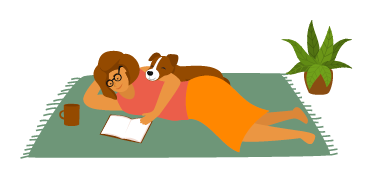
Toilet training spray
This is a great product to use when encouraging your puppy to toilet in a specific area, whether inside or outside.
Spray onto a training pad, newspaper or outdoor patch to attract your pup towards this spot at toilet-time. It speeds up the whole training process!
Puppy pads
Whilst your pooch is still acclimatising to going outside, accidents happen. If you keep discovering little ‘presents’ all around the house, puppy pads can be a real lifesaver – especially when carpets are involved!
These highly absorbent, odour-eradicating pads help manage the mess and keep your house smelling fresh.
Enzymatic cleanser
A wide range of pet shops stock non-toxic and safe enzymatic cleansers, perfect for eliminating poop and pee residue when indoor accidents occur.
Training clicker
A clicker is a fantastic way of positively reinforcing the ‘good dog’ message when training your pup. Your pooch can be conditioned to associate the clicker sound with praise and rewards, speeding up the whole toilet training process.
Dos and don’ts of house training
DON'T Rub your puppy’s nose in any toileting accidents
Training methods such as this only frighten, confuse and damage your beloved pup. Avoid it completely! The more your pup feels it can’t toilet in front of you, the longer the training process will take.
DO Use enzymatic-cleaning products to clean up accidents
Ammonia-based products such as bleach smell similar to urine and may draw your pup back to the same spot for a second round!
DON'T Feed your pup unsuitable foods
Indulging your pup with non-canine foods is bad for their health and may cause major toileting disasters! Salty foods make puppies drink much more water and produce a lot more pee! Many rich foods can cause diarrhoea and more.
DO Stick to a regular feeding schedule
An irregular feeding schedule can lead to issues such as overnight defecation. Feeding your pup according to a set schedule helps you time their outdoor toileting trips and speeds up the whole training process.
DON'T Expect miracles
It’s unlikely your pooch will be fully trained and accident-free in a matter of weeks. It’s important to set enough time aside to properly train your pup, building a solid foundation for lasting results.
DO Use specific cues
We caution against using cues you employ when praising other actions, such as “good girl” or “well done”. Your puppy will start to link toileting with this cue and you don’t want that!
DON'T Leave the back door open
It’s tempting to let your pup wonder in and out of the garden, toileting whenever he/she feels the need. However, this blurs the line between the garden being an area for toilet business and an area for play.
In the initial stages of toilet training, it’s best to keep boundaries clear.
DO Get some special training treats
Rewarding good toileting behaviour with some special, extra tasty treats is another way to encourage outdoor toileting, as it strengthens your pooch’s positive associations with the experience.
DON'T Leave your pup alone too long
When teaching your pup that indoor toileting is bad, it’s a smart move to avoid leaving them alone for too long. This decreases the chances of an accident happening indoors – that tiny bladder can’t hold on forever!
DO Keep up the positive reinforcement
Even once it seems like your pup has got the hang of outdoor toileting, remember young puppies need consistent, positive reinforcement. It’s easy to let bad habits slip in or old patterns return, so make sure you reward and praise every time your pooch toilets outside.
Chapter 4:
PUPPY BEHAVIOUR EXPLAINED
Puppies and young children have a lot in common.
Both learn about their surroundings through touch, taste, sight and sound, responding well to positive reinforcement. Both are adorable and highly distractible!
Many owners worry about what’s normal and what’s not when it comes to puppy behaviour. Why are your socks half chewed? Do your pup’s barks indicate a health problem? Why do they nip during play?
Whilst chewing, barking and play-biting are all normal puppy behaviours, it’s important to teach your pup to positively channel these habits, before negative patterns set in.
In this section, we’ll walk you through puppy behaviours and offer handy tips on how to handle them.
Chewing
When a puppy’s around, no prized possession is safe! Puppies have a natural urge to chew, so focus on guiding them towards chew-friendly choices.
Why do puppies chew?
As puppies develop, they need to find a way to explore and understand their environment. Unfortunately for your furniture and keepsakes, they like to do this with their mouths and razor-sharp puppy teeth.
Puppies are teething between the ages of roughly three to seven months. During the teething process, your pup’s need to chew is unstoppable, as chewing helps soothe painful gums. It also aids the removal of your puppy’s teeth and the arrival of adult teeth.
Chewing can also be an attention-seeking behaviour. Puppies need plenty of social interaction and stimulation, so if your furry friend’s deprived of company or exercise, they may resort to chewing simply for entertainment.
It’s normal for a puppy to chew whatever it can get its paws on, so punishing your pup for being too chew-happy is not the answer. Instead we’re going to focus on ways to positively reinforce good behaviour.
Manage the habit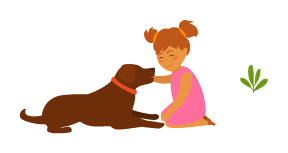
The best way to manage your pup’s chewing habit is through supervision. If you’re with your pooch, it’s much easier to stop unacceptable chewing in its tracks and reward good behaviour.
Puppies crave attention. Rather than shouting and frightening your pup when you catch them mid-chew, Dogs Trust suggests creating a distraction, such as leaving the room – your pup will probably follow. You can then give him/her something acceptable to chew, such as a toy, following this up with lots of praise.
If your pooch manages to sneak off and chew a favourite pair of trainers, don’t react angrily. Puppies can’t understand the link between your anger and an act they committed previously, so this will only cause them to fear you.
Your pooch may look guilty and run away or hide, but this is an act of submission. Puppies can feel threatened by factors such as body language and tone – they may even develop other destructive behaviours in response.
Ensure your puppy is getting an adequate level of socialisation. Unless you’re there to praise good conduct, chewing can become destructive. Exercise and exploring the great outdoors stimulate your pooch physically and mentally, lessening the urge to chew.
Manage chewing habits by stocking up on interesting, chewable toys. According to Paws, puppies are likely to pay more attention to new, unfamiliar items. It’s best to purchase several toys, rotating your pup’s selection to keep things engaging.
Here are the top four picks:
- Enrichment feeders
An enrichment feeder makes your pup work for its food. We recommend these, as pooches will instinctively use their mouths to get to the treats tucked inside, easing the chewing urge a little. - Play toys
You’ll find a wide array of pup-friendly toys in pet shops, ranging from soft to hard and rubbery to squeaky! It’s worth trying a few different options, sussing out which kind of toy your pup prefers. - Chews
Tasty chews are another great option for your pup to sink his/her teeth into! Make sure you pick puppy-friendly chews, keeping an eye out for choking hazards. - Flannels
For soothing gum relief, soak then freeze a flannel for your pup to chew on.
When you introduce your puppy to new toys, make sure you supervise. This is to ensure he/she can’t shred and then ingest parts of it, causing blockages in the stomach.
How to protect your house, furniture and belongings
- Purchase a crate or pen to keep your puppy in a safe, controlled environment when you’re unable to supervise
- Install baby gates to section off areas of the house
- Ensure dangerous items such as electrical wires, plug sockets and toxic plants are inaccessible
- Coat your furniture in Bitter Apple spray – your pup will not be a fan!
- Place special or valuable items in a secure location prying jaws can’t get to
- Keep kitchen bins and cupboards out of paw’s reach – foods such as chocolate and cleaning products such as bleach are toxic to dogs
When you’re out
We recommend keeping your pup in a restricted area such as a crate when you leave the house for short periods of time. This way you can choose what your puppy chews in your absence, leaving a selection of toys in their crate for them to play with.
Once your pup is older and trusted to stay outside the crate, have realistic expectations. Sometimes an off-limits object might be chewed! Blue Cross highlights that punishing upon your return will not only shock your pooch, it will generate anxiety and a lack of trust. Instead, act normally and replace with an acceptable chew.
Excessive chewing
While chewing is normal puppy behaviour, excessive chewing may take place for the following reasons:
Boredom – your pup may not be getting enough exercise or play
Anxiety – fear is a possible cause of excessive chewing. Always use positive reinforcement over punishment and check for any environmental triggers
Loneliness – in the early stages of puppyhood, companionship is vital, so ensure your pup is getting enough attention and love
Unbalanced diet – calcium deficit is a potential trigger for problem chewing. Consult a vet if you have any concerns
It’s useful to note that the canine need to chew never goes away entirely. Adult dogs chew to clean their teeth and exercise their jaws.
To curtail future chewing problems, make sure your adult pooch has a stimulating array of toys and gets to experience a variety of environments.
Barking
Although non-stop woofing quickly becomes a nightmare, barking is normal puppy behaviour.
A woof here and there is no bad thing!
Why do puppies bark?
Barking is a means of communicating for your pooch: a bark can signal excitement, curiosity, pain, fear or danger. Pups bark as a form of greeting or defence, and during play.
It’s best to work out why your puppy is barking rather than trying to eradicate the behaviour completely. Training is much easier once you know what’s triggering your pooch.
5 main causes of barking:
- Attention-seeking
Your pup craves your attention and sees it as a reward. If barking tends to garner a response from you, this incentivises the habit. - Boredom
Lonely and bored pooches sometimes have nothing better to do than bark. - Training
Puppies’ minds are still developing, so an inconsistent response to their bark will only bewilder them. Barking back at your pup is also a major no-no, as they may think you’re joining in! This could encourage them to do it even more. - Environmental
Something in your pup’s environment may be causing them distress. Perhaps the crate you’ve purchased is too small, or a specific sound frightens them? - Health
Your puppy could be barking because he/she is unwell or in pain. If barking and whining persist, it’s best to consult a vet to ask professional advice.
How to manage barking
Puppy training is all about positive reinforcement – like babies, they won’t understand harsh punishment. Gentle guidance and praise lead to a balanced dog, lessening the chance of problem barking. Here’s how to manage problem barking:
Ignore it
When your dog barks, don’t shout or pay attention. We suggest ignoring your pup’s barks until he/she stops. Don’t look and don’t touch or talk to your noisy canine. The second the barking stops, calmly praise and reward.
If you want this method to work, you must resist the urge to give in. If the barking continues and you respond, this again reinforces the idea that barking gets attention. We recommend turning your back and walking out of the room if the barking doesn’t stop. Puppies crave companionship, so if you return when they quieten, this helps your pup realise barking means no fun.
Desensitise them
If specific things cause your pup to bark, it’s worth following these tips on desensitisation training:
- To begin, ensure the stimulus (the barking trigger) is positioned a great enough distance away your pooch doesn’t feel the urge to bark. At this point, feed him/her plenty of tasty treats.
- Gradually inch the stimulus nearer and nearer, rewarding your pup with treats.
- Every time the stimulus drops out of sight, stop treating. When the stimulus reappears, treat your dog.
- Repeat this process several times, and after a while your pooch will positively associate with the stimulus in question.
- Puppies learn at different speeds, so do note it may take weeks before your pooch and the stimulus can be in the same spot without him/her getting distracted and barking.
- Likewise, we suggest practising door drills if your pup’s barks are triggered by the doorbell. Get a friend to pretend to ‘arrive’ at your home, ringing or knocking, then entering with treats for your noisy pooch. This will help them view visiting strangers in a positive light, lessening their sense of threat.
Tire your pup out
The more frustrated, bored and unstimulated your pup is, the more likely it is that barking will continue. Factors such as health, breed and age play a part in determining how much mental and physical stimulation your pooch needs. Lots of fun, walks and brain-games are great ways to tire the furball out!
Check out their environment
If certain sounds trigger barking, it’s worth turning on the radio for your pooch, especially when you can’t be around. Hearing voices and familiar non-threatening sounds will help diffuse anxiety and block out potentially scary noises, such as fireworks.
Teach your pup the “quiet” cue
Barking sometimes serves a useful purpose, acting as a means of defence. Teaching your pup the “quiet” cue helps them understand the difference between good and bad barking.
Follow these tips to teach them the “quiet” command:
- Before you commence training, grab your pup’s favourite treats so you have them to hand
- Make sure you have a means of triggering barks, such as a friend willing to ring the doorbell
- Pick the word you’ll use as your cue, such as “quiet” or “silent”
- Stimulate your pup’s urge to bark, then once it starts, quickly show you’ve acknowledged the trigger by glancing towards it
- Return to your pup, gaining his/her attention – perhaps wave a treat under their nose!
- Reward with the treat once the barking stops
- Repeat this process several times, each time leaving greater gaps of silence before rewarding
- After your pup has managed to stay quiet several times, start using your chosen cue as well
- When he/she starts barking, use the cue in a calm yet clear voice, showing the treat
- Once the barking stops, reward
- Keep up the good work!
Whining
Puppies can’t communicate their needs verbally, so whining is a means of highlighting a need – this is one of many reasons you should never shout at your pooch for whining.
Young pups often whine for attention, so make sure your canine is close to you throughout the day, getting adequate exercise, play and snuggles. While it’s vital your pup gets lots of love, make sure you fuss your puppy on your terms, not in response to attentionseeking behaviour.
When certain things make your pup anxious, remove the cause of distress (or your puppy) immediately. After this you can try desensitisation training, which we discussed previously.
If you’re concerned your pooch’s diet is insufficient or the whining is very frequent, consult a vet right away. Excess whining could be due to sickness or pain.
Mouthing, nipping and biting
They start as harmless puppy behaviour, but mouthing and nipping habits left unchecked can lead to more concerning issues once your pup matures. Teach your puppy that biting humans is a no-no from day one.
Don’t be alarmed if your adorable new furball nips you! As with any natural puppy behaviour, it’s all about positive training methods – harshly punishing a pup for play-biting is counterintuitive, increasing the likelihood of future aggression issues.
Why does my pup mouth and nip?
Like chewing, biting is a perfectly natural behaviour, often related to the teething process. As we discussed in our section on chewing, one of the reasons puppies bite is to relieve soreness and hasten teething.
Puppies learn about their environment through the use of their mouths – they also need to learn how their mouths work! From an early age, puppies play with their siblings by biting and mouthing. When you interact with your pup, he/she has no way of knowing the rules are any different.
Puppies’ teeth are very sharp, partly so they’ll develop ‘bite inhibition’. When they’re playing with the rest of the litter (and us), they learn to control how hard they bite through feedback.
If they bite too hard, the other puppy lets out a yelp and the game is instantly over. This lets the nipping puppy know that the fun stops when the bite is too hard. After consistently receiving this message, puppies begin to learn bite inhibition, lessening the pressure of their bites.
Puppies need and want plenty of attention. You’ll find your puppy often mouths your hand to initiate play and snuggles, or to communicate hunger.
Teaching your puppy bite inhibition
When teaching your pup bite inhibition, remember your furry friend primarily bites to elicit play and attention.
If your puppy bites, angry shouting will only frighten and confuse them. Physical punishment is never advisable, as pushing, slapping or hitting your puppy may trigger various negative outcomes:
- She/he could misunderstand, viewing the action as play, becoming more over-excited and boisterous
- Your pup may start to fear you, hiding and refusing to come near
- Cowering or cringing when people move hands near to her/his face, becoming “hand-shy”
- Getting defensive and trying to bite back
Teaching your pup bite inhibition can be a positive bonding experience. Here are some useful tips:
- Whether you’re petting or playing, every time your pup bites, in a medium pitch exclaim “ow!” or “ouch!” and stop all interaction immediately – this way your pup starts to learn that biting means zero play or attention
- As soon as your puppy stops biting, calmly reward and praise
- Resume petting or playing
- Repeat this process every time your pooch bites until it stops
- Ensure everyone follows this routine, be it family or friends
- If your puppy still bites during interactions, after exclaiming “ow!” or “ouch!” simply walk off and leave them alone
- Return after around fifteen seconds, continuing the game/petting
- Don’t carry this training out in your puppy’s crate, as this is where your pup comes for rest and security
- Ensure you keep up with the rules you’ve taught your pup, as tiring as it may be! Puppies learn through repetition and positive reinforcement.
What if my puppy continues to bite?
Hopefully by the age of three months, your pup knows not to bite hard. If he/she is persistently biting, consider using an indoor training line.
Every time your pooch bites, exclaim “ow!” or “ouch!”, then lead them to another room in a calm, gentle manner. Return after a maximum of thirty seconds, otherwise your pup may forget why they’re in trouble!
Give a familiar command such as “sit” or “lie down”, then continue interacting with your pooch, repeating if another bite occurs.
Rough play may encourage biting, so avoid games such as tug of war. Remember accidents happen – sometimes your pooch unintentionally bites. He/she may have pent up energy and need more exercise. Tiredness can lead to a rather irritable pooch, so make sure they get uninterrupted sleep at night.
If your pooch is excessively mouthing and nothing seems to help, it’s always worth consulting a vet as there could be an underlying medical cause.
How to spot the difference between play-fighting and real aggression
Every puppy is different and you can tell a lot about how your pup’s feeling by watching and listening to their behaviour. Removing your pooch from situations in which he/she feels threatened helps to combat negative patterns.
Signs your pup is play-fighting
- Your pup’s movements are relaxed and fluid
- They begin with a “play bow”, moving the chest and front legs closer to the ground, keeping the rump and hind legs upright – this is an incitement to play
- Tail wagging in a loose, relatively fast motion, possibly with the back end moving, too!
- Shorter, higher pitched play growls
Signs your pup is being aggressive
- Biting so hard the skin breaks
- Tensing up physically and appearing more focused, possibly raising hackles
- Baring teeth and letting out longer, louder rumbling growls
- Slow tail wags
Jumping up
Another puppy behaviour often rooted in a desire for attention is jumping up. This is a normal habit but should be discouraged early on.
Most puppies jump up as a means of greeting people, so before they have the chance, lower yourself to puppy height every time. If your four-legged friend still attempts to jump up, deny him/her any attention until it ceases. As soon as your pup stands back down, praise and reward.
Each time your puppy greets you and resists the urge to jump up, positively reinforce the behaviour with a treat and praise. Ensure family and friends follow this routine, too.
Chapter: 5
INTRODUCING YOUR PUPPY TO THE BIG, WIDE WORLD
If you want your puppy to grow into a calm and happy dog, socialising them from a young age is absolutely crucial.
It may be tough letting your little furball explore the big, wide world, but keeping them isolated indoors long term will do more harm than good.
When should I start socialising my pup?
Puppies, just like people, are highly impressionable when they’re young and must be socialised as early as possible. They need plenty of diverse, positive experiences. As they mature, they become more cautious and guarded, making it much harder to combat fears and phobias.
Once your pup is around 12 weeks old, they’re likely to feel apprehensive about unfamiliar situations and objects. Most puppies move to their new homes once they reach eight weeks of age, so owners must start acquainting their pooch with a variety of places, people and creatures right away, before the fearless phase ends.
At eight weeks, puppies should have been vaccinated, however their second vaccination won’t be until they’re ten to eleven weeks old, making many owners wary of socialising their pooch. There are several ways to get around this problem:
- Only allow them to interact with fully vaccinated dogs
- Avoid outdoor areas soiled with dog excrement
- Ensure family and friends play with your pup regularly, including sensible children
- Take your puppy to outdoor pooch-free areas frequently, to get them used to being outside
Meeting pets outside the home
While we discussed introducing new puppies to older family pooches earlier on in this guide, now it’s time to explore the wider canine world!
Once your pup is fully vaccinated, he/she can properly explore. When introducing your pup to other puppies and dogs outside the home, remember, bad experiences tend to be more damaging than no interaction at all.
While it’s good to socialise your pup with a variety of breeds, ensuring these dogs are friendly and safe is vital. A great way to socialise puppies is through ‘puppy parties’, offered by most vet clinics, as well as puppy training classes. Your pooch will be able to meet and play with other puppies in a safe, controlled environment.
When meeting dogs outside, do not force your puppy to approach – this could cause anxiety. Watch any canine interactions closely. Avoid letting any play become too boisterous, and if necessary, intervene by distracting your puppy with a treat or toy.
If the other dog gets too rough or excited, get down to your puppy’s level so they have a sanctuary to go to. Do not let the other dog intimidate yours. Always ensure your puppy has a means of leaving frightening situations – you want them to have positive experiences so their confidence can grow.
When your pup encounters other animals, ensure they are under control and unable to chase. Let your puppy observe, praising calm behaviour and rewarding with treats. If they get over-excited, let them observe from further away until they’re able to remain calm.
Interacting with children
It’s great to encourage play between puppies and children. Before this can happen, owners must teach children how to interact with their furry friends safely and gently.
Here are four useful tips!
- Always supervise interactions – never leave a puppy and a child alone.
- Prevent rough or over-excited play – encourage calm play and petting instead.
- Ensure the child knows not to force interaction, letting the puppy have space and peace, especially when eating or sleeping.
- Give the puppy a personal place to feel safe in, such as a crate, but keep it near to family activity.
Neutering your pup
Choosing to neuter your pooch is a personal choice, worthy of plenty of thought and research. This means surgically preventing your dog from reproducing. In a male dog, it’s called castration and in a female dog, it’s called spaying.
If you choose to go ahead, it’s ideal to do so before they reach sexual maturity, at around four months of age.
Here are a few reasons why you might want to neuter your pup including:
- Reduces risk of prostate disease in males
- Can have a positive effect on boisterous behaviour
- Stops unwanted pregnancies
- Stops unwanted sexual advances towards owners and visitors
If you’re unsure about neutering, talk through your options with a veterinary professional, or work out what’s best for your dog.
Taking your puppy out for the first time
It’s easy for us humans to forget how terrifying the world can seem to a puppy. That first foray into the great outdoors probably won’t be plain sailing, but patience and persistence will pay off. Let’s go!
Where?
First, we suggest you practice walking your pooch on a lead at home. Get your pup used to wearing a comfy collar that fits correctly, before attaching the lead. Encourage them to walk by your side with treats and praise, keeping the lead loose.
For your first outdoor trip, pick a quiet, peaceful spot for your pup to explore, away from traffic and crowds. If your furry friend seems fearful, don’t panic. Stay upbeat and balanced, exuding positive vibes. Come across another dog? Remain calm and encouraging, letting your pup approach if they wish.
When?
Puppies tend to have their first vaccinations at around six to nine weeks – the second round takes place three weeks later. Whilst you can take your pup outside after the first round, bear in mind the advice given earlier in this section regarding risk of infection.
How long should the first trip be?
We recommend calculating the appropriate length of walk by multiplying your pup’s age in months by five minutes. So, a three-month-old puppy would need a fifteen-minute walk!
On the first outdoor trip you may find your pooch is too nervous to walk for long, so build the time up gradually.
Vaccinations
Vaccinations protect your pup’s health and wellbeing. One injection alone is able to deliver multiple vaccines and protect your pooch from seven types of disease.
Typical vaccinations can protect puppies from the following diseases:
- Parvovirus
- Canine distemper
- Leptospirosis
- Adenovirus 1 and 2
- Canine parainfluenza
- Kennel cough
- Rabies
Type of lead and how to hold it
A lead keeps your pup safe and helps teach how to walk and act outdoors. Different breeds are better suited to different leads, so shop around to find the perfect pick!
Standard lead – loop handle, usually measures between four to eight feet. Clips onto your puppy’s collar. These are available in a variety of widths, weights and strengths, useful when looking for a lead suited to stronger breeds.
Slip lead – this lead includes a built-in collar that slips over your pup’s head. If your puppy tugs on the lead, the collar tightens, discouraging pulling.
Retractable lead – roughly 26-feet long, allowing your pooch more freedom. You can shorten the lead if required.
Adjustable lead – similar to a standard lead but with adjustable length.
Make sure you have a firm grip on the lead, but don’t pull it tight. Do not wind the lead around your fingers or wrists. Let it remain slack so your pup can walk comfortably. Watch out for cars or any other hazards.
Training and rewards
Whilst training a puppy takes time and patience, understanding how they learn speeds up the whole process. We know puppies learn best when they’re rewarded for good behaviour with praise and treats.
Positive reinforcement helps create a link between action and reward, making a puppy more likely to repeat good actions. As long as you keep your training consistent and fair, your pup should grow into a balanced and content pooch – everyone wins!
Training classes
Puppy training classes tend to come as package deals. A six-week course ranges from roughly £40 to £80 – a worthwhile investment. Your puppy will be able to improve his/her social skills, interacting with other puppies in a calm and controlled environment, building confidence and learning basic commands.
Reward-based training
Most trainers use reward-based methods to teach puppies. Let’s walk through teaching the “sit” command with reward-based training:
- Hold a treat above your pup’s snout, luring them into a sitting position as your hand moves back and their head tilts upwards.
- As soon as your puppy sits, use the “sit” command.
- Straight after this, reward with the treat.
- Keep it up!
- Your pup can then progress to learning commands such as “stay”, “lie down” and “come”.
Clicker training
Clicker training is another method centred on positive reinforcement. Without holding the clicker too close to your pup’s face or ears, start by clicking once then immediately follow with a treat. Repeat this process until you feel your pup clearly expects a treat after the click.
After this, every time your pup exhibits a desired behaviour, click during the act, not after, then reward straight away.
Clicker training is another great way to speed up your pooch’s learning in a positive way. Clickers can be found in most pet shops, so get clicking!
Chapter 6:
PROTECTING YOUR PUPPY FOR THE FUTURE
As you’ll know by now, puppies are bold and brave and keen to explore! And while you should encourage this behaviour, you’ll also want to do all you can to protect them.
Having the right dog insurance in place means that your pup will get the help it needs and the financial burden will be taken off of you.
The cost of dog insurance claims
Did you know that the average pet insurance claim is £793* – that’s a huge amount to find if your pup has an accident or falls ill unexpectedly. As the Association of British Insurers (ABI) explains, the overwhelming majority of claims from pet owners today are for veterinary bills, as medical treatment for our fourlegged friends becomes ever-more sophisticated.
But it’s not just vet bills puppy owners have to consider. What about if your pup was stolen? Or lost? Or was liable for damage they caused to someone else’s property? Dog insurance can help you financially in all these scenarios – meaning that you’re protected well beyond accident or illness alone.
Senior Policy Advisor for the ABI John Ahern spells out the dangers to puppy owners. “There is no NHS for animals, so if you’ve not got a pet policy in place, you risk having to foot veterinary bills out of your own pocket,” he says. “These can often be in the thousands of pounds and vet treatment is only getting more expensive, not less.”
The good news is that insurers paid out a recordbreaking £785 million in pet claims in 2018 and more pets are being covered than ever before, so don’t let your pup miss out!
Insurance for your dog at Purely Pets
The friendly team at Purely Pets can help you find the perfect dog insurance policy for your puppy – and your pocket – with benefits including:
- 24-Hour Vet Helpline
- Manage My Policy portal
- Cover for boarding fees up to £2,000*
- Cover for loss by theft or straying up to £2,000*
- Cover for complementary treatment up to £2,000*
* Available on Lifetime Gold Cover policies only
Top 4 common dog insurance claims
New puppies are more prone to accidents and injuries. Some of the most common claims we handle here at Purely Pets include:
- Growth/Tumour
- Heart Disease
- Arthritis
- Epilepsy/fits
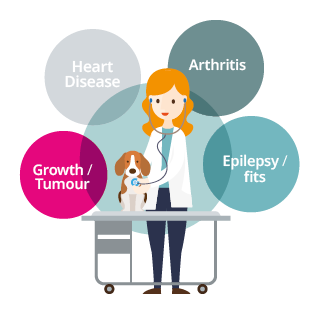
*Figures published by the Association of British Insurers
Want a downloadable copy?
Includes the Ultimate Puppy Guide Checklist.
Now We’d Like To Hear From You
We hope you found this new puppy training guide helpful.
Now we’d like to hear what you have to say:
Which tip from today’s post do you want to try first?
Are you going to use special training treats?
Or maybe you’re going to implement positive reinforcement.
Either way, let us know by leaving a comment below.
